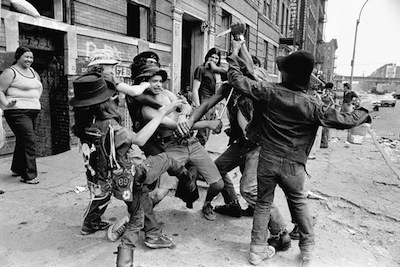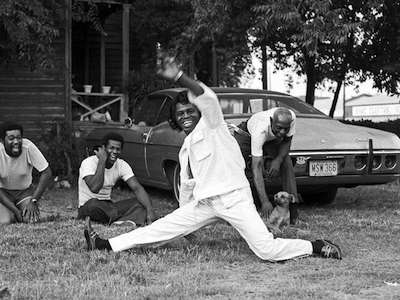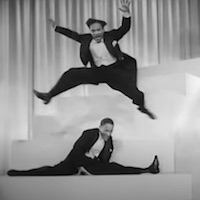Influences, sources of inspiration outside of breaking that have helped shape aspects of the dance. While breaking's form is intricately tied to the breaks, the battle mentality, and individuals' imaginations, external influences have always existed. In Ken Swift's view,
Early Influences
Dancers' influences during the early-to-mid 1970s are considered here. Naturally, the environment was a source of inspiration, which included social dance, gangs,1 and anything on TV or in movies. These influences contributed to the early movements of breaking (e.g. toprock, burns, drops, footwork) as well as its practice and overall approach. It should be noted, however, that influence was not restricted to simple imitation (cf. bite), nor was it in every case unidirectional. Rose contends, "Hip hop's development in relationship to New York cultural politics in the 1970s is not unlike the relationship between other major cultural expressions and the broader social contexts within which they emerged. [...] Yet, the emergence of hip hop's styles and sounds cannot be considered mere byproducts of these broad sweeping forces" .
James Brown, Nicholas Brothers
Some professional dancers were familiar to early breakers. James Brown's dancing is cited as an influence by Kurtis Blow, Sasa, the Legendary Twins, Imperial JC, and Trac 2 , among others (his music likely affected all early breakers). While one can imagine the influence of Brown's intricate footwork, or funky style combining fluid movement with sharp accents (and even complete freezes) driven by his music, it is his drops (e.g. a knee drop, drop into a push-up, and split) that early breakers tend to cite in particular . The drops also reflected the great physicality of his dancing, and were usually only used during the "bridge" of the song—aspects echoed in breaking.
Brown's attitude expressed in his dance may also have been an influence, especially in contrast with other mainstream dancers. Alice Echols writes on this distinction, "there was no mistaking the tough-looking James Brown with his streetwise swagger for the Temptations, whose dance steps were taken from the street but who possessed the sort of supper-club sheen characteristic of crossover black entertainers" . Coupled to this was Brown's "lack of restraint, his embrace of "His Bad Self'" , which manifested in his energetic moves.
James Brown discusses his eponymous dance,
The Twins also mention the Nicholas Brothers as a major influence . Their style has been described as, "a melding of jazz, tap, acrobatics, and black vernacular dance," sometimes incorporating "daredevil splits, slides, and flips" . Like Brown, their moves, physicality, and performativity were early sources of inspiration.
Gang Dances

Work in progress
Burning
Work in progress
Uprock
Uprock, or rock, rock dance, rocking, Brooklyn rock, combative dance characterized by burns, aggressive or insulting gestures, and jerks,2 a class of movements including certain drops and lunges. In Frosty Freeze's description, "uprock is just like humiliating, you know, doing things in people's face and all that" . Uprock was part of the 1981 battles between the Rock Steady Crew and the Dynamic Rockers at United Skates of America (the "rocking contest" seen in Style Wars) and later at Lincoln Center, with other notable instances in Beat Street and the music videos for "Planet Rock" and "Uprock." Reflecting this, Guzman-Sanchez claimed that "uprocking blended in and became a standard part of the second-generation local B-Boy dance scene" around 1980 and 1981 . Some breakers claim earlier influence, however, as Popmaster Fabel registered, writing, "some practitioners believe top rockin's first inspiration came from uprocking. The two forms developed simultaneously from similar inspirations yet kept their own identities" . Uprock-inspired movements continue to be incorporated into breakers' rounds, while entire uprock battles also arise, on occasion.
The modern form of uprock, or at least many of its recognizable features, crystallized by the mid-to-late 1970s, among rocking crews such as the Little Dave Rockers, Touch of Rock, Dynamic Spinners, and Dynasty Rockers. Uprock is performed for a song's full duration, rather than only the break, with close attention paid to musical details. Typical songs included "Listen to Me," "It's Just Begun," and "Give It Up or Turnit a Loose" . Uprock is done against an opponent, often with others forming two lines of people, referred to as the Apache Line (e.g. ). Dancing is simultaneous, and therefore involves negotiating space with the opponent, as well as quickly reacting to their movements. The dance resembles a fight, though touching, or even keeping insufficient distance, is normally forbidden3—historically, violating this rule would stop the dance and, often, start a fight. The dance includes freestyle, burns, and jerks, and is primarily done standing, with drops and some floor moves. A four-beat pattern involving a burn and a drop, described by Schloss and Guzman-Sanchez, is common, particularly during a song's break.
Little Dave and Bushwick Joe recalled uprocking against others in the early 70s in Central Park, Highland Park, and Coney Island . They brought boomboxes to provide music, sometimes wiring multiple together . Little Dave commented on who they battled, "the cliques, they used to wear MC boots. While we had our Converse, and all that" . Here, "cliques" almost certainly refers to gangs—"MC boots" suggests the Black Spades, who Sunshine claimed were "the only gang running around here with boots on" and whose presence on Coney Island in the early 1970s is well documented (e.g. ), though photographs have shown that members of other gangs wore engineer boots as well, and motorcycle gangs are yet another possibility. Joe put forward, "that's why the cliques created rocking. They didn't want to fight, they wanted to rock. Have a good time. That's what it's all about. That's how I learned it" . This in fact posits a break between the gangs and uprock, echoed by Buz, for whom uprock "was what got me away from the gang" . Bronx rocker Willie "Marine Boy" Estrada distinguished between late 1960s "Outlaw Rock," which he called "the first form of Rock Dance," and "a new form of Rock Dance" emerging in the early 1970s . Papo 774, who began uprocking around the time "Long Train Runnin'" was released in 1973, would then consider that, "to say that gangs were the ones who created rock is, to me is not true" —he discerned that, rather than continuing gang traditions, gang-like qualities imprinted on uprock, since "the way of life back then was gang life. There were gangs everywhere" . Individuals have been mentioned, in addition to names like Rubberband , including Joe's brother-in-law—an "original rocker in the 60s" —and Eddie Puma, who, notably, was an early influence for Papo 774 , Danny Dan , and Carlos .
In the Bronx, dancers like Marine Boy, Enoch Torres, and Frank "Papo" Rojas referred to their dance as "rock" in the late 1960s and into the 1970s . This dance included neither jerks nor burns—Rojas recalled some instances of jerking, but held that "there were two kinds of Rock": one more "spectacular", and the other where "they danced" . Papo 774 commented on an early encounter with Bronx rockers, "they had that Frank Rojas style. That moving their feet and going in a circle stuff [...] I found it a little too simple, too soft" . Papo 774 described the years around 1973 to 1975 as, "when it was just rock. When it was burning. Not even the jerk was present, the jerk came a little later on. Who created it, I don't know. How did it get it's name, I don't know" . Carlos has also stated that "back then it's called burning" . It is this stage of uprock that resembles what is described by Trac 2 and Aby . Danny Boy indicated that jerks were uncommon even around 1976 . Duz claimed that Buz taught him jerks , while Buz has declared, "where the jerk comes from, I don't know" . The mid-1970s saw the emergence of rocking crews—prior to this, gang pressure discouraged any visual crew representation . Danny Boy got the name for his crew from the film Dynasty (1977) . In Manhattan, the Sureshot Boys' Amigo Rock has described, "uprocking back in those days was just, you know, guys getting in a circle and doing burn moves. You know, grab your head, go 'uhh.' Go like this or that. No jerks involved" . Amigo Rock, with Mingo Rock, battled with the Rock Steady Crew at the 1981 Lincoln Center battle to compete with the Dynamic Rockers , exposing the dance to a new audience just as it entered into eclipse. In the 1990s, renewed efforts to spread uprock were led by King Uprock and others.
Martial Arts
Work in progress
Gymnastics
Work in progress
Later Influences
Folk Dances
Work in progress
West Coast Funk Styles
Work in progress
Hip Hop Dance
While breaking is the original dance of hip hop, subsequent dances that would come to be called hip hop dance would influence breaking in turn. The influence of hip hop dance can be seen, for example, in the "leg hop" thread , and some breakers' toprock.
Hip hop dance developed around 1985 or 1986 as breaking and popping became less popular, and in response to new music . Buddha Stretch recalls,
Hip hop dance is an improvisational dance that incorporates elements of numerous other styles, including social dances, breaking, popping, locking, the hustle, Memphis Jookin, and many others, on top of each individuals' style. It is often danced to hip hop music, lending the dance its name . Some choreographed dances are occasionally called hip hop dance, as well.
House
Work in progress
Capoeira
Breakers drew inspiration from capoeira in the 1990s , with some claiming its influence began earlier . Jelon Vieira, the first teacher of capoeira in the USA, arrived in New York in 1975 , although whether or not any breakers saw him is uncertain. A significant collision of capoeira and breaking occurred in 1993 when Mestre João Grande shared a performance with the Rock Steady Crew . It is difficult to estimate the extent of capoeira's influence on modern breaking due to the substantial overlap in both movement and philosophy. Some examples of similar movements are corta capim and the sweep or helicopter, queda de rins and the baby, and aú batido and nike. Julie Delgado theorizes that, "though they came to be hundreds of years and thousands of miles apart, both cultures maintain the traditions of the African Diaspora: movement as a vehicle for mental transcendence, oral history, respect to musicians and transgression of oppressive circumstances" .
Capoeira has been described as "an Afro-Brazilian cultural practice – simultaneously a fight and a dance – that can be interpreted as a tradition, a sport and even an art form" , and a "dance-fight-game" . Its complex history spans several centuries, with early written accounts appearing in 1770 and 1809 . Regarding its origin, Nestor Capoeira writes, "the origin of capoeira, whether African of Brazilian, has stimulated many discussions up to the present day. Even the most important mestres, such as Bimba (1900–1974) and Pastinha (1889–1981), had different ideas on this subject" .
A reflection written by Mestre Brasília in Vivência e Fundamentos de um Mestre de Capoeira evinces aesthetics similar to that of breaking,
Yoga
Work in progress
Circus Arts
Work in progress
Tricking
While many flips and kicks in breaking were inspired by gymnastics, street performance, martial arts, etc., it has become increasingly common for breakers to cite the influence of tricking.
Tricking has been described as a combination of martial arts, parkour, breaking, and gymnastics . Steve Terada recalls that in the mid-1990s, before the name "tricking" was widespread, "they would call them tricks. 'Cause there were only, I don't know, five foundational moves, really. 540 aerial, pop 720, maybe... And everything else was just considered martial arts" . Precursors to modern tricking (alternatively, early tricking) can also be seen in Xtreme Martial Arts competitions. Tricking experienced a significant rise in popularity in the 2000s, aided by websites like club540.com, bilang.com, and later youtube.com .
Footnotes
- Here, "gang" refers to groups such as the Black Spades, Ghetto Brothers, Savage Skulls, etc.
- Definitions of "burn" and "jerk" in uprock vary among dancers. The simultaneous ubiquity and variation in these movements even discourages convergence on precise definitions, though many identify as a jerk at least the four-count pattern involving sharp movements, or components of it. Vitamin Da Governor, with King Uprock, suggested that the modern emphasis on the jerk emerged in part from efforts to distinguish uprock from other dances .
- Regarding uprock's no-contact rule, as well as the level of disrespect allowed in burns, Schloss, paraphrasing Amigo Rock, tells us that it could be "more vicious between friends, since they could be expected to take burns in the proper spirit" .

